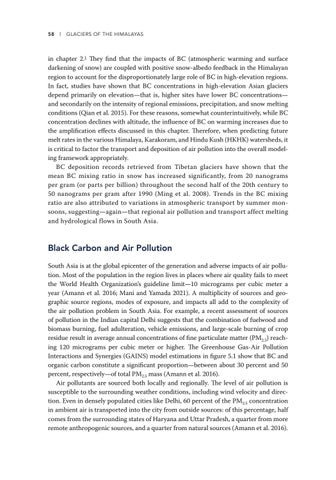58 l Glaciers of the Himalayas
in chapter 2.1 They find that the impacts of BC (atmospheric warming and surface darkening of snow) are coupled with positive snow-albedo feedback in the Himalayan region to account for the disproportionately large role of BC in high-elevation regions. In fact, studies have shown that BC concentrations in high-elevation Asian glaciers depend primarily on elevation—that is, higher sites have lower BC concentrations— and secondarily on the intensity of regional emissions, precipitation, and snow melting conditions (Qian et al. 2015). For these reasons, somewhat counterintuitively, while BC concentration declines with altitude, the influence of BC on warming increases due to the amplification effects discussed in this chapter. Therefore, when predicting future melt rates in the various Himalaya, Karakoram, and Hindu Kush (HKHK) watersheds, it is critical to factor the transport and deposition of air pollution into the overall modeling framework appropriately. BC deposition records retrieved from Tibetan glaciers have shown that the mean BC mixing ratio in snow has increased significantly, from 20 nanograms per gram (or parts per billion) throughout the second half of the 20th century to 50 nanograms per gram after 1990 (Ming et al. 2008). Trends in the BC mixing ratio are also attributed to variations in atmospheric transport by summer monsoons, suggesting—again—that regional air pollution and transport affect melting and hydrological flows in South Asia.
Black Carbon and Air Pollution South Asia is at the global epicenter of the generation and adverse impacts of air pollution. Most of the population in the region lives in places where air quality fails to meet the World Health Organization’s guideline limit—10 micrograms per cubic meter a year (Amann et al. 2016; Mani and Yamada 2021). A multiplicity of sources and geographic source regions, modes of exposure, and impacts all add to the complexity of the air pollution problem in South Asia. For example, a recent assessment of sources of pollution in the Indian capital Delhi suggests that the combination of fuelwood and biomass burning, fuel adulteration, vehicle emissions, and large-scale burning of crop residue result in average annual concentrations of fine particulate matter (PM2.5) reaching 120 micrograms per cubic meter or higher. The Greenhouse Gas-Air Pollution Interactions and Synergies (GAINS) model estimations in figure 5.1 show that BC and organic carbon constitute a significant proportion—between about 30 percent and 50 percent, respectively—of total PM2.5 mass (Amann et al. 2016). Air pollutants are sourced both locally and regionally. The level of air pollution is susceptible to the surrounding weather conditions, including wind velocity and direction. Even in densely populated cities like Delhi, 60 percent of the PM2.5 concentration in ambient air is transported into the city from outside sources: of this percentage, half comes from the surrounding states of Haryana and Uttar Pradesh, a quarter from more remote anthropogenic sources, and a quarter from natural sources (Amann et al. 2016).




